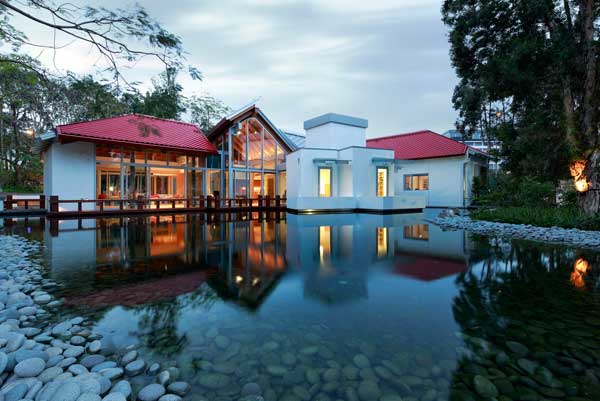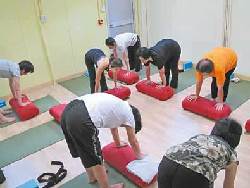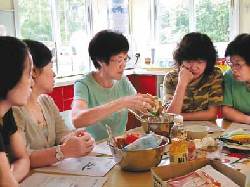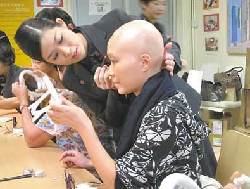Center of hope and support
Updated: 2013-08-20 22:44
By Rebecca Lo (China Daily)
|
|||||||||||
When the Big C strikes, it is often what happens afterwards that is crucial to the patient and the patient's family. In Hong Kong, an inspirational concept has launched a place where the sick can learn to heal themselves. Rebecca Lo drops by to find out more.
Maggie Keswick Jencks first battled breast cancer with a double mastectomy. When it returned for the third time, it had spread to her liver, bones and bone marrow. Although she had their support, she knew that her husband Charles Jencks and two teenage children needed her. She vowed to battle the disease with every means possible to gain more time with her family.
 |
|
Furnished with ponds and gardens, Maggie’s center offers a private and delightful space for cancer patients to relax. Kalson Ho / for China daily |
Growing up between China and Scotland as the only child of John Keswick and a family of Jardine Matheson tycoons, she was familiar with the benefits of traditional Chinese medicine.
She felt that while hospitals treated the disease, there was a gap between what they could provide and the kind of emotional and psychological support that gave a patient hope.
Jencks wrote A View from the Front Line at the request of her surgeon Mike Dixon for medical journal The Breast. It is a cancer patient's firsthand account. It also sowed the seed that eventually blossomed into Maggie's Cancer Caring Centre.
"Most hospital environments say to the patient, in effect: ‘How you feel is unimportant'," wrote Jencks. "‘You are not of value. Fit in with us, not us with you'. With very little effort and money, this could be changed to something like: ‘Welcome! And don't worry. We are here to reassure you, and your treatment will be good and helpful to you'. Why shouldn't the patient look forward to a day at the hospital?"
Jencks worked with Edinburgh architect Richard Murphy to convert a small building within Edinburgh's Western General Hospital's grounds into a drop-in center.
It was intended to be an uplifting place housed in transformative architecture. Patients and their family or caregivers could source information about the disease and alternative treatments, participate in group programs and counseling sessions, share experiences with like-minded people or have a quiet place to reflect.
It was a plan to help patients help themselves. The sick can take ownership for how they wish to continue living with the disease.
Jencks died in 1995, a year before the first Maggie's Cancer Caring Centre was open to the public.
Nearly two decades later, Jencks' friend and architect Frank Gehry unveiled his second Maggie's in Hong Kong.
The single story, purpose-built structure is situated near the grounds of Tuen Mun Public Hospital, allowing patients to drop by as they wait for their treatment session or doctor's appointment.
Hong Kong has a total population of more than 7 million. Tuen Mun Hospital's catchment area is about 15 percent of that, or roughly 1.1 million people. Newly diagnosed cancer cases in the city were about 26,000 in 2011, with approximately 10 percent of that is in the Tuen Mun and New Territories West area.
Gehry worked with local architect Ronald Lu & Partners on the project pro bono. Jencks' daughter Lily designed the landscape around the building.
Like the other centers, the architecture is inspirational. It features a large kitchen as the heart and soul of the sunlight-drenched spaces. For those needing time on their own, there are many terraces that overlook reflecting ponds and the gardens where they can contemplate in privacy.
Funded and operated by The Keswick Foundation, Maggie's Hong Kong offers individual support through professionals, such as cancer information specialists, clinical psychologists and social workers.
There are relaxation sessions to teach patients how to manage stress. There are support groups for people to share their experiences — or just to vent frustrations.
Popular classes include Chinese and Western nutrition, tai chi and yoga. In addition, there are creative writing courses, art therapy and concerts. All of its programs are free to the public, with some of the more popular courses requiring registration.
"We opened a temporary center in 2008 and moved here in April," says Helen Lui, Maggie's center head.
"While we are a drop-in center open to coincide with most users' doctors appointments during the day, we are available on an as-needed basis. For example, we have a Saturday yoga class for working women. And we have a young women's group on Friday evenings. They face different issues than their senior counterparts and most work during the day."
More than 80 percent of Maggie's approximately 12,000 users are female, and there are classes designed specifically for them.
"Our ‘look good, feel better' class help ladies deal with the loss of their hair or damage to their complexion. Makeup artists show them how to apply products for a natural look. Many local women don't know what they can achieve with cosmetics — with just a little effort, they can be beautiful again. Patients are much happier when they've regained their confidence."
Lui explains that the yoga and tai chi classes are conducted by specialists who work with cancer patients.
"Unlike yoga studios where it's about how well you can do a headstand, there is no pressure to go beyond your comfort zone. That can lead to frustration instead of benefitting. Participants are taught to understand their physical limitations and how they may injure themselves if they push too hard."
While nutrition classes promote healthy eating, they also are chances for patients to socialize.
"We are all in good moods if we have good appetites," says Lui. "Our regular users get a chance to show off their skills. One taught us how to make bread, for example. The cooking and nutrition classes are fun. Though patients need to be mindful of eating healthy, we teach them that it's ok to have a spoonful of sugar or some butter every now and then. And it is natural for our community to sit at the round dining table and interact with new patients over a cup of tea."
Lui points out that the Hong Kong center offers a slightly different program than its counterparts in the United Kingdom.
"They don't offer traditional Chinese medicine, while creative writing is not as popular here," she explains.
She believes that Maggie's provides something to the local community that the social services run by the Hong Kong government lacks.
"We use our center to help facilitate social activities," she says. "Before I started working at Maggie's, I never realized how architecture could be such a huge contributing factor. Users love coming here. They learn that it's not just about their own illness — they are all in the same boat at Maggie's. They are among friends."
 |
 |
 |
|
Maggie's Cancer Caring Centre in Hong Kong helps patients through a variety of sessions, like yoga, nutrition and makeup classes. photos provided to china daily |
Related Stories
Scientists invent device for safer cancer therapy 2013-08-08 15:56
Study reaffirms 'cancer villages' 2013-08-08 08:10
Bad habits add $34b to annual cost of cancer: study 2013-07-03 11:26
Support group's activities help cancer patients 2013-07-04 07:55
Today's Top News
More New Zealand dairy products banned
Snowden reporter to publish UK secrets
China, Kenya agree to bolster relations
Typhoon wreaks havoc in the south
Western program engine for growth
Egypt's Mubarak may be freed
Bank's position to stay 'prudent'
ROK-US drill goes ahead as tensions ease
Hot Topics
Lunar probe , China growth forecasts, Emission rules get tougher, China seen through 'colored lens', International board,
Editor's Picks

|

|

|

|

|

|





